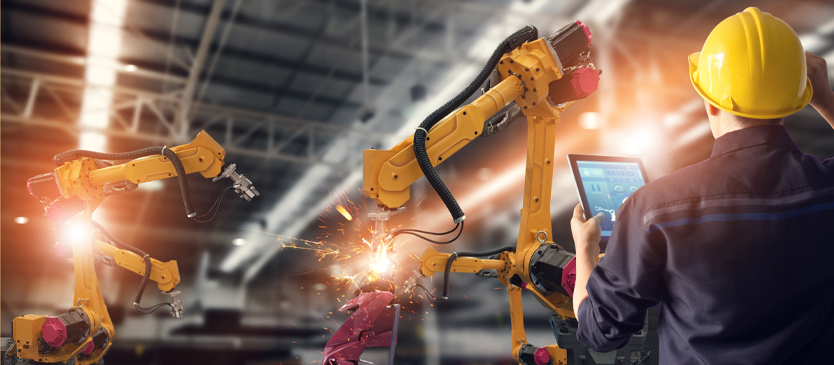Innovations in robotics have thrived in the automotive industry for over 75 years. What’s new are the latest applications of this evolving technology, and new management systems to imbed in the process to achieve efficiencies. These applications make industrial robotics applicable far beyond the automotive industry, and likely into your industry as well.
In today’s manufacturing systems, industrial robots are usually employed for three main segments of industrial application:
- material handling
- processing operations
- assembly and/or inspection
Within that segmentation, other tasks may include:
- machine loading
- palletizing (packing and picking)
- parts transfers
- quality inspection
- welding
- painting
Six types of industrial robots accomplish these varied tasks:
- Articulated (a robot with rotary joints for a full range of motion)
- Cartesian (inexpensive robots with three linear joints on an X, Y, and Z-axis)
- Cylindrical (typically a single arm that moves up, down, and/or around a central pole)
- Spherical (for movement in a 3-D space)
- Selective Compliance Assembly Robot Arm (SCARA, arms articulated like human wrists)
- Delta (spider-like for delicate, precision movements)
Workplace Safety
Industrial robotics increases workplace safety as hazardous tasks can be assigned to the robots. Robots are well suited to tackle repetitive tasks but also tasks that may have movements or involve positions that make a human worker uncomfortable or fatigued. Some labor might require a tool that is weighty or awkward to handle, or potentially expose people to injury. The proper placing of robots in the manufacturing workflow can alleviate some of these potential friction points while mitigating workplace risk. And as other pundits have pointed out, robots don’t get tired, and they don’t need breaks—an efficient, cost-effective robotic labor force can extend the working hours in your facility or factory.
Using Robots in Various Industries
Commercial Construction
The application of robots extends beyond the manufacturing space and has become entrenched in other industries, too. The commercial construction industry has implemented several real-world robotics applications. Traditionally, surveyors conducted a field layout using tape measures, chalk lines, and surveying equipment to manually demark the location of mechanical systems, walls, doorways, and the like. Now, small floor marking layout robots can identify exact locations on concrete floors with pinpoint precision. This capability enables robots to follow instructions applied directly to the concrete surface. This automated process saves operational time, as workers don’t have to keep going back to check with the plan in the office. Human error is avoided through incorrect measurement or misinterpretation of the blueprints. Simply put, the use of robots improves efficiencies.
Agriculture
The agricultural industry has used robotics for quite some time as many of the tasks associated with large-scale food production operations are ripe for the technology. From planting to harvesting, shepherding, pruning, and spraying, robots have already made an impact on the food supply chain. The deployment of drones looks to be a future application of emerging robotic innovations with ongoing experiments involving the platforms in planting, cloud seeding, and weed control solutions. But beyond the fields and greenhouses, modern robotics steers food production and processing workflows as well: palletizing, labeling, sorting, cutting and slicing, picking, and placing for raw and processed foods all benefit from the speed and precision of robot technology.
Laboratories
Laboratories have long used robots for the handling of hazardous materials, for working in environments that could be contaminated by human presence, and in various testing procedures. The electronics industry uses similar applications of robots in their clean-room environments, but also for assembly and pick-and-place tasks to boot. The pharmaceutical industry has been a big growth space for robot technologies, and the medical industry as a whole has found more and more utilization of industrial robotics.
Workshops
Workshops and small production environments may also realize some efficiencies from the thoughtful application of robotic technology. Coding and marking are just one specific example of a myriad of potential applications for these types of smaller workspaces. Implementation of REA JET’s technologies doesn’t have to involve a massive financial commitment or workflow revolution; these solutions can be introduced gradually and over time in incremental tranches. Consider whether these improvements nest within your strategic business goals, as the benefits are often realized over the long term.
It’s easy to see how the employment of industrial robots across a broad array of market segments has been a boon to the manufacturing industry. REA JET’s latest innovations in coding and marking technology allow manufacturers to focus on improving workflow and increasing efficiency while staying within budget. Update your technology for maximum efficiency at lower costs; decrease your downtime and increase your ROI by leveraging the proper emplacement of industrial robotic technology.

